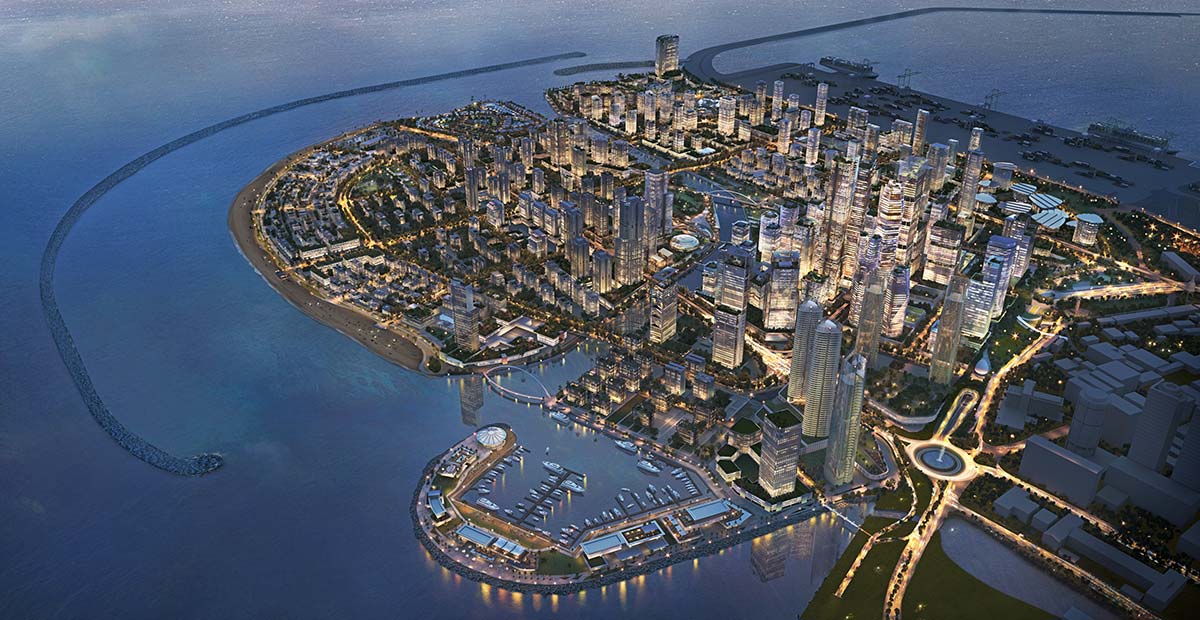
- Home
- Rising Perspectives
- Shaping the Future of Sustainable Urban Development: How Port City Colombo is Building Sri Lanka’s Blue and Green Future
In boardrooms from London to Singapore, one conversation continues to dominate strategic agendas—sustainability. Cities worldwide are no longer merely expanding; they are fundamentally reimagining their growth models to balance climate resilience, competitiveness, and long-term liveability. What was once optional has become the benchmark of economic strength and social progress. For business leaders and investors, the message is clear: the future of sustainable urban development must be climate-resilient, energy-smart, and environmentally restorative.
This transition is urgent. According to the United Nations, by 2050, nearly 70% of the world’s population will live in urban areas, making cities the epicentre of both opportunity and risk. For investors, this urban transition demands foresight: which cities are prepared to lead in sustainability, and which will be left behind?
In Sri Lanka, one answer stands tall against the Indian Ocean horizon: Port City Colombo. Envisioned as the country’s first multi-services Special Economic Zone (SEZ), Port City Colombo represents more than a landmark real estate development—it is a blueprint for sustainable urban development in Sri Lanka grounded in green infrastructure, renewable energy, and climate-smart urban design. It aligns with the UN Sustainable Development Goals (SDGs) and positions itself as a catalyst for the sustainable urban development of Sri Lanka.
In the corridors of the United Nations, the 2030 Agenda for Sustainable Development has set a clear direction: growth must go hand in hand with environmental stewardship. Two goals define the urban future—SDG 11 (Sustainable Cities and Communities) and SDG 7 (Affordable and Clean Energy). Together, they form the backbone of a global mandate: cities must transform or risk being left behind.
The urgency of this transformation is undeniable. By 2050, nearly 70% of humanity will live in urban areas (UNDESA, 2019), turning cities into the very stage where the drama of sustainability will play out. Today, cities consume over two-thirds of the world’s energy and are responsible for more than 70% of CO2 emissions (UN-Habitat, 2020). The International Renewable Energy Agency (IRENA, 2023) warns that reaching net-zero by 2050 means raising renewable energy’s share in electricity generation from 30% in 2022 to 90% within three decades.

What the world calls urgency, visionary cities see as possibility. The cities that embrace renewable energy, green mobility, and climate-smart infrastructure will not only safeguard their people—they will become magnets for investment, innovation, and talent. They will set the benchmarks for economic competitiveness in a world where sustainability is currency.
For Sri Lanka, this global mandate offers both a challenge and an opportunity. At the edge of the Indian Ocean, Port City Colombo is writing its own chapter in this unfolding narrative. Conceived as more than a new urban city, it is envisioned as a model of sustainable urban development in Sri Lanka—embedding green infrastructure, renewable energy adoption, and circular economy principles at its core. In doing so, it aligns itself with the SDGs while positioning the nation as an emerging player in the global renewable future.
Sri Lanka’s renewable transition isn’t just aspirational—it’s advantaged. Blessed with abundant sunshine, strong coastal winds, cascading rivers, and vast oceanfront, the island is naturally positioned to harness renewable energy at scale. Sri Lanka already sources nearly 50% of its electricity from renewable sources, largely hydropower, and has set an ambitious target of 70% renewable energy by 2030 and becoming carbon neutral by 2050. This aligns with its Nationally Determined Contributions (NDCs) under the Paris Agreement and resonates with SDG 7: Affordable and Clean Energy.
But this transition is more than a policy target; it is a national narrative. Each rooftop solar panel, each wind farm along the Mannar coast, and each hydropower project in the central highlands tells the story of a country that is learning to power its growth without compromising its future. Renewable energy is becoming not just a utility but a strategic lever—reducing dependence on imported fossil fuels, enhancing energy security, and attracting global investors. Increasingly, competitiveness is being measured through sustainability metrics.
Placed in the global context, Sri Lanka’s ambitions are striking. Singapore’s renewable target is limited to 2 gigawatt-peak (GWp) of solar power by 2030, constrained by land availability. India is targeting 500 GW of renewable capacity by the same year, while Denmark—a pioneer in wind power—plans for 100% renewable electricity by 2030. While Sri Lanka’s absolute scale is smaller, its 70% renewable energy mix target is bold and proportionally more ambitious than many larger economies, signalling a strong policy direction and commitment to sustainability.
This ambition also aligns with global capital flows. According to the International Energy Agency (IEA), investment in renewable energy surpassed US$1.7 trillion in 2023, representing nearly two-thirds of global energy investment, with solar attracting more funding than oil for the first time in history.

At Port City Colombo, the future is being built with sustainability embedded in its foundations. The city’s design integrates sustainable energy buildings featuring advanced insulation, solar shading, and high-efficiency cooling systems to reduce carbon output. These innovations are guided by Sri Lanka’s Net Zero Vision 2050, ensuring every building contributes to emissions reduction.
In upholding global environmental standards, two comprehensive Environmental Impact Assessments (EIAs) were conducted for different phases of Port City Colombo’s development—covering reclamation, breakwater, and vertical development phases. Both EIAs were evaluated and approved by the Department of Coast Conservation and Coastal Resources Management.
Of the project’s total 269 hectares, 91 hectares are dedicated to public spaces—40 hectares of which include green and beach areas. Nearly one-third of the city remains open, breathable, and ecologically balanced, a vital feature of liveable, low-carbon urban environments.
Going beyond design, Port City Colombo has also introduced a pioneering sustainability incentive framework to encourage developers to integrate environmental performance into their projects. Under this scheme, developers are incentivised based on two key prerequisites:
1. Increasing the landscaping quotient on plots above the minimum required landscape coverage.
2. Attaining the highest rating from any Green Certification Scheme registered with the World Green Building Council (WGBC).
Upon meeting any one of the above prerequisites, developers are eligible for an increase of up to 2% of Gross Floor Area (GFA). Upon meeting both prerequisites, they can be incentivised with an increase of up to 5% of GFA.
For investors, this means access to green infrastructure investment opportunities that combine profitability with long-term resilience.
Transportation accounts for nearly a quarter of global emissions. Recognising this, Port City Colombo has designed its sustainable transport and mobility strategy around low-emission systems, pedestrian-first planning, and cycling infrastructure.
Electric vehicle charging stations, dedicated cycle lanes, shaded walkways, and a proposed water transport system through energy-efficient water taxis will define how residents and professionals move within the city—reducing congestion while promoting cleaner, smarter mobility choices.
The benefits of sustainable mobility extend beyond emission reduction—they shape healthier lifestyles, improve air quality, and enhance liveability, making the city a desirable destination for international investors and talent alike.

Water is both a necessity and a vulnerability for island nations. As emphasised during World Water Week 2025 (24–28 August, Stockholm), water resilience is no longer a peripheral sustainability issue—it is the foundation upon which future-ready cities are built. With climate change intensifying rainfall patterns, sea-level rise, and drought cycles, urban developers are rethinking how water is managed, reused, and celebrated within cities.
Port City Colombo reflects this global insight through an integrated, forward-looking approach to water management in Sri Lanka. The city integrates rainwater harvesting, greywater recycling, and storm water retention systems that minimise flood risk and maximise reuse—turning a vulnerability into a strategic asset. In doing so, Port City Colombo directly aligns with SDG 6 (Clean Water and Sanitation) and reinforces how renewable energy in Sri Lanka and sustainable water management can together build climate resilience.
Yet, what makes Port City Colombo distinctive is its philosophy of Blue Engagement—the seamless integration of natural ecosystems and built infrastructure within the city’s master plan. Open water bodies, green zones, and urban development coexist in a harmonious layout, creating a city where nature and architecture complement each other.
The Channel, which flows through the heart of the city into the Marina and the Beach, is more than an aesthetic feature—it is a living system. Water naturally circulates every 72 hours, maintaining quality and ecological balance while creating accessible, vibrant waterfronts for recreation, commerce, and community life.
Sustainability at Port City Colombo extends from land to sea. It employs a sustainable waste management project built around the 3R principle—Reduce, Reuse, Recycle. Through source segregation, organic waste conversion, and waste-to-energy initiatives, the project reduces landfill dependence and prevents toxic runoff into the Indian Ocean. This integrated approach ensures that urban growth does not come at the cost of marine health.
Beneath the surface, Port City Colombo’s sustainability extends into the sea. An ecological survey recorded more than 100 species of fish and over 70 coral types near the project’s 3.2km breakwater—a living testament to the city’s commitment to biodiversity. Port City Colombo has introduced eco-engineered coastal infrastructure designed to protect marine life and promote coral regeneration, aligning with SDG 14: Life Below Water.

Global research indicates that cities of the future will be judged by their ability to decarbonise, adapt, and enhance resilience. Port City Colombo is not waiting for tomorrow—it is implementing these systems today.
By aligning with Sri Lanka’s renewable energy targets, embedding green infrastructure, investing in sustainable mobility, and protecting marine biodiversity, Port City Colombo is shaping a future where business growth and environmental stewardship converge.
For investors, this is not just a real estate project—it’s a future-proof, ESG-aligned city offering measurable impact and long-term returns.
Visit Investor Relations or Contact Us to place your inquiry and explore how you can invest in Sri Lanka’s clean, green, and sustainable future.
The future of investment is green—and Port City Colombo is at its centre.
PCC has integrated the latest sustainability measures and incorporated Environmental, Social, and Governance principles from a foundation level to establish itself as a “Green and Blue SEZ” while focusing on the live-work-play aspect. As a maritime location, PCC offers activities and experiences that incorporate key waterfront locations — including the first beachfront development in Colombo, a luxury yacht marina, and an array of water-based activities such as canoeing and water taxis — the latter focusing on reducing vehicular traffic and lowering the overall carbon footprint.
By adhering to sustainable construction guidelines, land developers can enjoy an additional 5% GFA allocation at Port City Colombo. The DCRs encourage sustainable development in the Port City Colombo and set a roadmap for world-class, eco-friendly developments.
A set of 72 strict conditions were imposed by the CC&CRMD in their approval for Environmental Impact Assessments (EIA) 1, and 52 conditions for EIA 2. All the conditions stipulated by the authorities are being abided by Port City Colombo (the Project Company).
